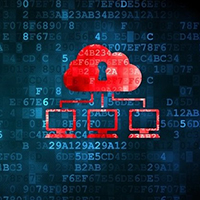In This Issue
- Video Eats Internet
- Cybersecurity Repair
- Cloud Security Spend
- Report from the CEO
- Verizon Buys Yahoo
- Telefonica and Cloud
- VZ Adds Cloud VNFs
- Amazon Hires Legend
- Dan Schnapp to SMNY
- Hybrid Flash Array
- Edge and Cloud Comp
- Cyber in IoT & Mobile
- Block next WannaCry
- US Blames No Korea
- Op Model Transform
- Cyber Pro Top Traits
- Coming DCIA Events
Video Continues to Eat the Internet
Excerpted from Multichannel News Report by Jeff Baumgartner
 Video will account for about 82% of all global IP traffic by 2021, up from 73% in 2016, Cisco Systems concluded in its latest Visual Networking Index.
Video will account for about 82% of all global IP traffic by 2021, up from 73% in 2016, Cisco Systems concluded in its latest Visual Networking Index.
The study, which forecasts key IP trends from 2016 to 2021, also expects to see gaming apps gain ground, rising to 4% of all global IP traffic by 2021, up from just 1% in 2016.
Back to video, the global IP networks will be pumping out 3 trillion Internet video minutes per month by 2021, equal to 5 million years of video per month, or about 1 million video minutes every second.
More than half (56%) of connected flat panel TVs will be 4K-capable and up by 2021, versus 15% in 2016, with the installed/in-service base of 4K sets set to rise from 85 million in 2016, to 663 million by 2021.
Ultra HD video, meanwhile, is expected to account for 21% of global IP video traffic by 2021, compared to HD video (57%) and standard-def video (22%).
Among other notable video-related findings, Cisco said a global cord-cutting household will generated about 117 gigabytes per month… Read More
US Cybersecurity in Need of Rapid Repair
Excerpted from Roll Call Report by Griffin Connolly
 Massachusetts Senator Edward Markey is concerned about cybersecurity deficiencies in the private sector, particularly in utility companies.
Massachusetts Senator Edward Markey is concerned about cybersecurity deficiencies in the private sector, particularly in utility companies.
Cybersecurity in the United States is in a severe state of disrepair, leaving the country vulnerable to attack from hacking groups backed by its opponents, two witnesses testified in a Senate Subcommittee hearing Tuesday.
The witnesses told the Senate Foreign Relations Subcommittee on East Asia, the Pacific, and International Cybersecurity Policy that they believe a massive cyberattack is imminent unless the US ratchets up its efforts to protect against and deter offensives from countries such as Russia, China, and North Korea.
Eric Rosenbach, who was Chief of Staff to former Defense Secretary Ashton Carter, told lawmakers he believes a large-scale attack by North Korea against the United States “is likely to happen within the next year, if current trends continue.”
Quoting Chinese officials, Samantha Ravich, who advised the George W. Bush White House on national security, described China’s aggressive cyber-offensive strategy as “a form of nonmilitary warfare, which is just as terribly destructive as a bloody war, but in which no blood is actually shed.” Lawmakers agreed with the witnesses’ warnings… Read More
Cloud Security Spend to $3.5 Billion by 2021
Excerpted from CloudTech Report by James Bourne
 Cloud security spending is set to hit $3.5 billion by 2021 at a 28% annual growth rate, according to a new report from Forrester Research.
Cloud security spending is set to hit $3.5 billion by 2021 at a 28% annual growth rate, according to a new report from Forrester Research.
The report, authored by analysts Jennifer Adams and Andras Cser, discusses a variety of trends, from cloud security risk, to traditional security tools.
According to the figures, cloud security gateways will continue to be the primary route of global spending, contributing to $1.6 billion – or 45% – of the overall figure by 2021.
Native infrastructure as a service (IaaS) and platform as a service (PaaS) will come in to the tune of $1.1 billion, while hypervisor security and centralized cloud workload security management are at $0.5 billion and $0.3 billion respectively.
Financial services represent the larger market for cloud services today and will continue to do so until at least 2021, the report adds.
This marks an interesting point — the report rightly points out that the idea of cloud-based services in financial would be controversial… Read More
Report from DCIA CEO Marty Lafferty

In a departure from reporting on the impacts of mobile cloud, edge computing, cybersecurity, big data, social networking, or the internet of things on the distribution of high-value content, this week we celebrate a milestone in the delivery of such content.
Nearly a quarter century after initially being proposed, the Olympic Channel will launch on July 15th to more than 35 million homes.
The original proposal, entitled the Olympics (plural) Channel, was made to the International Olympic Committee (IOC) and US Olympic Committee (USOC) as a follow-up to the first multi-channel coverage of the Summer Games that took place in 1992 with distribution to over 40 million US TV households through a joint venture of NBC and Cablevision.
NBCUniversal, which has consistently won the rights to US television distribution of the Summer and Winter Games for three decades, is partnering with the IOC and the USOC on the new network, subtitled “Home of Team USA.”
The channel will highlight American athletes in live year-round coverage of Olympic sports and be available from launch to most subscribers of Altice, AT&T, DirecTV, Comcast, Spectrum, and Verizon.
Its acceptance by major established multi-channel video programming distributors (MVPDs), along with the fact that the linear feed also will be streamed on DirecTV Now, Fubo, Hulu, Sony PlayStation Vue, and YouTube TV, reflects the continuing appeal of the Olympic brand in the US.
The Olympic Channel also will be live streamed on OlympicChannel.com, the Olympic Channel app, NBCSports.com, and the NBC Sports app, with replays and highlights available on these platforms as well as TeamUSA.org.
The DCIA views this launch as a harbinger of more breakthroughs for live streaming of high-value targeted content and multi-platform distribution, combining traditional television programming outlets with newer over-the-top (OTT) entrants accessible on a full array of connected devices.
Share wisely, and take care.
Verizon Completes $4.48 Billion Purchase of Yahoo
Excerpted from NY Times Report by Vindu Goel
 Verizon Communications, the wireless powerhouse that was a cluster of local phone companies when two Stanford University graduate students began compiling the Yahoo web directory in 1994, completed its purchase on Tuesday of Yahoo’s internet business for $4.48 billion.
Verizon Communications, the wireless powerhouse that was a cluster of local phone companies when two Stanford University graduate students began compiling the Yahoo web directory in 1994, completed its purchase on Tuesday of Yahoo’s internet business for $4.48 billion.
Yahoo, which once had a market value of $125 billion, will be combined with AOL, another faded web pioneer it bought in 2015, into a new division of Verizon called Oath.
Oath, headed by AOL’s chief executive, Tim Armstrong, will have about 1.3 billion monthly users, and Verizon hopes to use its range of content and new forms of advertising to attract more viewers and marketers as it competes against Google and Facebook.
The company also intends to cut costs, with plans to lay off about 2,100 people, or about 15 percent of Oath’s staff.
Oath’s strategy will be to place the same content – whether articles, videos or ads – in multiple locations to reach the widest possible audience, said Marni Walden, the Verizon Executive Vice President who oversees its global media businesses.
“I think of the Oath business almost like a shopping mall,” Ms. Walden said in an interview at Yahoo’s Sunnyvale, CA headquarters… Read More
Telefonica Steps up Cloud with VMware & Huawei
Excerpted from BNAmericas Report by Pedro Ozores
 Spanish telco Telefonica activated a new cloud solution for the business segment using virtualization technology from VMware over Huawei’s servers installed in Telefonica’s data centers.
Spanish telco Telefonica activated a new cloud solution for the business segment using virtualization technology from VMware over Huawei’s servers installed in Telefonica’s data centers.
Telefonica’s Virtual Data Center (VDC) 3.0 portfolio is available to corporates in Spain, the UK, Argentina, Brazil, Chile, Colombia, Mexico, Peru, and the US.
In Brazil, the portfolio was dubbed Vivo Cloud Plus 3.0. Vivo is the commercial brand of Telefonica Brasil.
The solution is targeted principally to Telefonica’s mid-sized and large customers, those requiring infrastructure services and in need of moving workloads to the cloud.
Basically, it allows companies to have a dedicated physical environment with the same characteristics of as a virtual data center.
With the launch, Telefonica claims to become the first company in Latin America to offer a fully automated hybrid cloud with VMware technology. VMWare reportedly has 80% of the global virtualization market… Read More
Verizon Adds Cloud-Based VNFs
Excerpted from Light Reading Report by Carol Wilson

Verizon this week rolled out its cloud-based virtual services for enterprise customers, adding that option to both its gray box and white box edge solutions for typical applications such as firewalls and WAN optimization.
The new “as-a-service” virtualized network functions will give enterprises new options and are most typically going to be used in addition to premises-based deployments, says Victoria Lonker, Executive Director, Network and Virtual Solutions at Verizon.
She tells Light Reading in an interview that most customers are looking to perform some functions in the cloud and others at the edge or on premises.
“For example, some customers are actually putting SD-WAN functions at the edge, at their prem, but they are looking at maybe putting some of the advanced firewall and security capabilities in the cloud because then that cloud-based firewall could serve more than one site versus having to put a single virtual or physical firewall at each customer site or location,” Lonker says.
In other instances, enterprises may be consuming cloud-based services that Verizon delivers using physical firewalls within its infrastructure… Read More
Amazon Hires a Computing Legend
Excerpted from NWI Times Report by Billy Duberstein
 Many people know Amazon for its dominant retail operations and smart-home speaker Alexa.
Many people know Amazon for its dominant retail operations and smart-home speaker Alexa.
However, the company’s fastest-growing and most profitable segment is Amazon Web Services.
AWS is the company’s cloud computing division, which allows businesses to store their data and applications in Amazon’s massive data centers.
“Renting” space from Amazon is far cheaper and more flexible than traditional on-premise solutions, which is why cloud computing is turning the enterprise IT world upside-down.
AWS grew a whopping 42.7% in the most recent quarter while posting a 24.3% operating margin.
Synergy Research Group puts AWS at 40% cloud market share, almost double that of Microsoft, Alphabet, and IBM combined.
According to IDC, the cloud market is set to grow 25% this year, making it one of the highest-growth industries today.
Still, with so much going right, Amazon is never one to stand still. In fact, the company just hired a computing legend… Read More
Sheppard Mullin Adds Entertainment Partner Dan Schnapp
Excerpted from MarketWired Press Announcement
 Daniel E. Schnapp has joined the New York office of Sheppard, Mullin, Richter & Hampton LLP as a Partner in the Entertainment and Digital Media practice and as Co-Leader of the firm’s Technology Transactions Team.
Daniel E. Schnapp has joined the New York office of Sheppard, Mullin, Richter & Hampton LLP as a Partner in the Entertainment and Digital Media practice and as Co-Leader of the firm’s Technology Transactions Team.
Schnapp joins from Hughes Hubbard & Reed LLP where he was Chair of the firm’s New Media, Entertainment and Technology practice.
Joining Schnapp are former Hughes Hubbard associates Alexis Robinson and Genevieve Perez.
“We are very excited to have Dan and his team on board.”
“He is extremely talented and a highly versatile technology transactions attorney who has handled a wide variety of complex transactions across multiple industries for more than two decades, most notably entertainment and digital media.”
“He greatly bolsters our already prominent Entertainment and Digital Media practice and overall technology transaction capabilities,” said Jon W. Newby, Vice chairman of Sheppard Mullin.
Schnapp and his team advise multinational corporations, as well as midcap and startup companies… Read More
Growing Global Demand for Hybrid Flash Array Storage
Excerpted from CloudTech Report by David Deans
 The emergence of hyperscale cloud service providers transformed the enterprise computing environment.
The emergence of hyperscale cloud service providers transformed the enterprise computing environment.
IT infrastructure vendors have learned to adapt to shifts in market demand and embrace the ongoing changes that have affected the data center server and storage markets.
Enterprise CIOs and CTOs have also modified their traditional budget allocations.
Total worldwide enterprise storage systems factory revenue was down 0.5 percent year-over-year, reaching $9.2 billion in the first quarter of 2017 (1Q 17), according to the latest global market study by International Data Corporation (IDC).
Total capacity shipments were up 41.4 percent year-over-year to 50.1 exabytes during the quarter.
Revenue growth increased within the group of original design manufacturers (ODMs) that sell directly to hyperscale data center operators.
This portion of the market was up 78.2 percent year-over-year to $1.2 billion.
In contrast, sales of server-based storage were down 13.7 percent during the quarter and accounted for $2.7 billion in revenue… Read More
The Difference between Edge and Cloud Computing
Excerpted from CIO report by Gary Eastwood
 The rise in cloud traffic that is expected as a result of increasing applications of the internet of things (IoT) might render cloud computing unmanageable.
The rise in cloud traffic that is expected as a result of increasing applications of the internet of things (IoT) might render cloud computing unmanageable.
IoT hinges on processing device generated data and cloud computing involves using data from centralized computing and storage.
Thus, this computational model can become overwhelmed if the growth trajectory of IoT continues as it has been.
The unprecedented amount of data generated by IoT devices is putting considerable strain on the internet architecture.
Consequently, developers are finding ways to alleviate this network pressure and get around the data problem.
One of the proposed solutions to this issue is edge computing.
This data processing archetype involves pushing data handling to the edge of the network, closer to the source of the data.
Instead of sending data to the cloud server or central data center for processing, the device connects through a local gateway device… Read More
Cybersecurity in an IoT and Mobile World
Excerpted from ZDNet Report by Jason Hiner
 Cybersecurity fears continue to grow as the digital revolution embeds itself in new parts of society every day.
Cybersecurity fears continue to grow as the digital revolution embeds itself in new parts of society every day.
We discuss the topic in-depth in our ZDNet/TechRepublic special report “Cybersecurity in an IoT and Mobile World.”
To sum it all up, here are the three things you need to know about cybersecurity in world that is increasingly dominated by mobile technology and the internet of things (IoT).
1. Mobile is now the standard.
For the past decade and a half, mobile devices were bolted onto a company’s IT strategy because the devices themselves were what professionals used when they were traveling or between times when they were sitting at a computer.
Today, there’s a lot more you can do on mobile and so mobile usage continues to skyrocket.
As a result, every company needs to treat mobile like a central component of its IT, data, and cybersecurity policies.
2. IoT complexity brings tremendous risk… Read More
How to Help Block another WannaCry
Excerpted from ITBoB Report by Rick Saia
 Is outdated technology increasing your customers’ risk of getting hit with a data breach?
Is outdated technology increasing your customers’ risk of getting hit with a data breach?
Chances are it could, according to security ratings firm BitSight, which analyzed more than 35,000 companies around the world about the link between the usage of outdated computer operating systems and Internet browsers, technology-updates practices and exposure to data breaches.
A key finding?
Over 2,000 organizations run more than half of their computers on outdated versions of an operating system, making them almost three times as likely to experience a publicly disclosed breach.
“I wouldn’t be surprised if that shouldn’t be higher,” said Michael Stolarczyk, Vice President of Sales and Business Development for cloud services at Duluth, GA based solution provider VeriStor, No. 242 on CRN’s Solution Provider 500 list.
BitSight said its research coincides with last month’s “WannaCry” ransomware attack that affected more than 300,000 computers across a variety of industries… Read More
US Blames North Korea for DDoS Attacks
Excerpted from Gizmodo Report by Kate Conger
 The Department of Homeland Security (DHS) and the Federal Bureau of Investigation (FBI) issued a rare cybersecurity bulletin linking North Korea to a series of attacks that have targeted US businesses and critical infrastructure since 2009.
The Department of Homeland Security (DHS) and the Federal Bureau of Investigation (FBI) issued a rare cybersecurity bulletin linking North Korea to a series of attacks that have targeted US businesses and critical infrastructure since 2009.
The alert focuses on a malware strain called DeltaCharlie, which DHS and FBI say was used by the North Korean government to launch distributed denial of service attacks.
DDoS attacks use floods of web traffic from compromised devices to knock websites or services offline.
North Korea targeted “the media, aerospace, financial, and critical infrastructure sectors in the United States and globally,” the alert says.
The US government refers to North Korea’s hacking team as Hidden Cobra, but cybersecurity firms often use the slightly less sinister name Lazarus Group.
The North Koreans have also been linked to the WannaCry ransomware that spread virally in May and shut down hospitals and businesses… Read More
Use Cloud to Achieve Op Model Transformation
Excerpted from TechTarget Report by Mark Tonsetic
 The shift of IT infrastructure to the cloud isn’t a question of if, but when and how much.
The shift of IT infrastructure to the cloud isn’t a question of if, but when and how much.
Survey data collected last fall by CEB, now Gartner, indicates that the average organization expects to triple the share of capacity it allocates to public cloud services across the next two to three years.
The share allocated to internal private clouds or more conventional, on-premises infrastructure will continue to decline, assuming current trend lines endure.
Why? Have the economics anticipated in Nicholas Carr’s The Big Switch come to pass, and will computing essentially become a utility?
Not exactly, and not yet.
Additional data we collected from IT leaders indicates that the economics of cloud vary by organization.
Slightly more than half reported that costs of running in the cloud were more expensive than on-premises alternatives, while the other half reported savings from running in the cloud… Read More
Traits of High Potential Cybersecurity Professionals
Excerpted from TechRepublic Report by Macy Bayern
 When hiring cyber security professionals, curiosity, reliability, and being a lifelong learner are as important as technical skill.
When hiring cyber security professionals, curiosity, reliability, and being a lifelong learner are as important as technical skill.
Employers seeking to fill the cyber-skills job gap should turn their attention to “New Collar” workers, David Jarvis, security and CIO lead of IBM’s Institute for Business Value (IBV), told TechRepublic’s Dan Patterson in an interview on Monday.
Jarvis explained that the purpose of IBM’s IBV is to develop research based on leadership on emerging businesses and technology and how they interact.
Recently, Jarvis has been focused on cyber-security and security education, specifically best practices for security leaders.
With the significant rise in new technology this past decade, Patterson notes the particular relevance of cyber-security and the growing cyber-skills job gap.
Jarvis explained that IBM is addressing both concerns with their “New Collar approach,” focusing on sets of individuals from a variety of backgrounds, not just four year institutions.
Not all high tech jobs require a four year university background, rather, a specific set of skills, Jarvis said… Read More
Coming Events of Interest
Industry of Things World Asia — July 3rd and 4th in Singapore. An international knowledge exchange platform bringing together more than 300 high-level executives who play an active role in the industrial internet of things (IoT).
Industry of Things World Europe — September 18th and 19th in Berlin, Germany. Join more than 1,000 high-level executives to rethink your technology and business strategy for scalable, secure, and efficient IoT.
IoT Solutions World Congress — October 3rd through 5th in Barcelona, Spain. This event has grown enormously in no time and is an excellent barometer and source of information, inspiration, collaboration and transformation.
INTRASECT— November 1st and 2nd in Washington, DC. The first conference of its kind to engage key stakeholders in a comprehensive and engaging examination of existing and future regulatory policy governing the usage of commercial autonomous vehicles.
